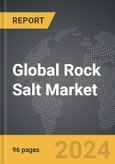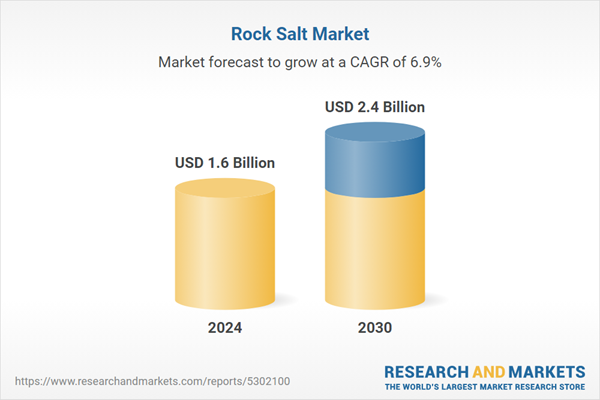Global Rock Salt Market - Key Trends and Drivers Summarized
Why Is Rock Salt So Essential in Daily Life and Industry?
Rock salt, a naturally occurring mineral form of sodium chloride (NaCl), is much more than just a culinary ingredient. Its role extends far beyond the kitchen, with widespread use in various industries and everyday applications. Rock salt is a key resource for food preservation and seasoning, having been used for centuries to enhance flavors and extend the shelf life of perishables before refrigeration technology became commonplace. In addition to its culinary applications, rock salt is extensively used for de-icing roads and walkways during winter. When temperatures drop, applying rock salt helps melt snow and ice by lowering the freezing point of water, ensuring safer travel and reducing the risk of accidents. This de-icing application is particularly important in countries that experience harsh winter conditions, making rock salt a critical part of public safety infrastructure. Beyond these everyday uses, rock salt plays an integral role in water treatment, chemical production, and agriculture. In water softening systems, rock salt is used to regenerate ion exchange resins, removing hard minerals from water and extending the lifespan of plumbing systems. In chemical industries, rock salt serves as a raw material in the production of chlorine and caustic soda, which are key components in a wide range of products from plastics to cleaning agents. In agriculture, rock salt is sometimes added to animal feed to ensure proper electrolyte balance in livestock. Whether in homes, industries, or on the roads, rock salt is a versatile mineral that is indispensable in many aspects of daily life.How Has the Rock Salt Industry Evolved to Meet Modern Needs?
The rock salt industry has undergone significant evolution, shaped by both technological advancements and changing consumer and industrial demands. Historically, rock salt was mined primarily for its use in food preservation and flavoring, but today, its industrial uses far surpass its culinary applications. Modern mining techniques have made the extraction of rock salt more efficient and sustainable. Traditional methods, such as deep-shaft mining, are still used in large-scale operations, but newer techniques like solution mining, which involves dissolving the salt in water and then pumping the brine to the surface, are gaining popularity. These methods not only reduce the environmental impact but also allow for the extraction of purer forms of salt with fewer impurities, meeting the higher standards required for industrial use. Another key development in the rock salt industry is the growing demand for specialty salts. As consumers become more health-conscious and environmentally aware, there is a rising preference for natural and minimally processed salts, including Himalayan pink salt and sea salt, both of which are often perceived as having additional health benefits due to their trace mineral content. This has led to the growth of niche markets within the broader rock salt industry. Additionally, environmental concerns have prompted the development of more eco-friendly de-icing alternatives. While rock salt remains the most widely used substance for road de-icing due to its affordability and effectiveness, companies are exploring blends of rock salt with other compounds that reduce the overall environmental impact, such as corrosion inhibitors to protect infrastructure or additives that improve its effectiveness at lower temperatures.What Are the Considerations for Using Rock Salt Across Different Applications?
When using rock salt, it is important to consider the specific needs and implications across different applications, whether in food, de-icing, or industrial use. In culinary settings, the purity of rock salt is crucial, particularly when used for direct consumption or food preparation. Culinary rock salt must be free of harmful contaminants, and its crystal size and texture can affect how it dissolves and interacts with food. Large, coarse crystals of rock salt are often preferred for tasks like curing meats or for use in salt grinders, while finer grains may be better suited for everyday cooking. Additionally, many consumers are becoming more aware of the mineral content in different types of rock salt, such as Himalayan pink salt, which contains trace amounts of iron oxide, giving it a distinctive pink hue and a unique flavor profile. In industrial and road de-icing applications, different considerations come into play. The effectiveness of rock salt as a de-icing agent depends on factors such as particle size, spreading efficiency, and environmental impact. Larger crystals are often more effective in melting ice, as they stay on the surface longer and release salt gradually. However, environmental concerns arise with extensive use, as the runoff from salt-treated roads can damage vegetation, contaminate groundwater, and corrode infrastructure. As a result, municipalities and industries are increasingly looking at the environmental footprint of rock salt use and seeking ways to mitigate negative effects through improved application techniques, blending with other materials, or using alternative de-icing agents in sensitive areas. In the chemical industry, the purity of rock salt is paramount, as even trace impurities can affect chemical reactions and product quality. High-purity rock salt is essential in the production of chlorine and sodium hydroxide through electrolysis, and any contaminants in the salt can lead to inefficiencies or defects in the final product. These considerations demonstrate the importance of selecting the right type and quality of rock salt for each application, ensuring both efficiency and safety in its use.What Are the Factors Fueling the Expansion of the Rock Salt Market?
The growth in the rock salt market is driven by several factors that span across both consumer demand and industrial needs. One of the primary drivers is the increasing use of rock salt for de-icing and road safety, especially in regions that experience heavy snowfall and icy conditions. As urbanization increases, the need for safer roadways in winter months has led to higher demand for rock salt, as it remains the most cost-effective solution for managing snow and ice. Additionally, as climate change leads to more unpredictable weather patterns, even regions that previously experienced milder winters are now investing in rock salt reserves to prepare for harsher conditions. This has expanded the market for rock salt beyond traditional cold-climate areas. The demand for rock salt is also growing in the food industry, as consumers shift toward natural and unprocessed food products. Specialty salts, such as Himalayan pink salt and other gourmet varieties, have seen a surge in popularity due to their perceived health benefits and unique flavor profiles. This trend is driving increased production of rock salt, particularly in regions known for high-quality deposits. Furthermore, industrial uses of rock salt in chemical production, water treatment, and agriculture continue to contribute to the market’s growth. The chemical industry, in particular, relies heavily on rock salt as a raw material for producing chlorine, sodium hydroxide, and other important compounds, ensuring steady demand from this sector. Lastly, sustainability concerns and environmental regulations are shaping the future of the rock salt market. While rock salt remains the dominant choice for de-icing, there is growing interest in finding more environmentally friendly alternatives or improving the way rock salt is applied to reduce its negative effects. This has led to innovations such as treated salts, which are more effective at lower temperatures and require less frequent application, reducing both costs and environmental impact. These factors - ranging from increased urbanization and food industry trends to ongoing industrial applications and the push for sustainability - are collectively driving the expansion of the rock salt market.Report Scope
The report analyzes the Rock Salt market, presented in terms of units. The analysis covers the key segments and geographic regions outlined below.Segments: Application (Flavoring Agents & Food Preservatives, De-Icing, Chemical Intermediates, Water Treatment, Agriculture, Other Applications).
Geographic Regions/Countries: World; United States; Canada; Japan; China; Europe (France; Germany; Italy; United Kingdom; Spain; Russia; and Rest of Europe); Asia-Pacific (Australia; India; South Korea; and Rest of Asia-Pacific); Latin America (Argentina; Brazil; Mexico; and Rest of Latin America); Middle East (Iran; Israel; Saudi Arabia; United Arab Emirates; and Rest of Middle East); and Africa.
Key Insights:
- Market Growth: Understand the significant growth trajectory of the Flavoring Agents & Food Preservatives segment, which is expected to reach US$853.2 Million by 2030 with a CAGR of a 8.3%. The De-Icing segment is also set to grow at 5.8% CAGR over the analysis period.
- Regional Analysis: Gain insights into the U.S. market, valued at $405.6 Million in 2024, and China, forecasted to grow at an impressive 10.7% CAGR to reach $578.5 Million by 2030. Discover growth trends in other key regions, including Japan, Canada, Germany, and the Asia-Pacific.
Why You Should Buy This Report:
- Detailed Market Analysis: Access a thorough analysis of the Global Rock Salt Market, covering all major geographic regions and market segments.
- Competitive Insights: Get an overview of the competitive landscape, including the market presence of major players across different geographies.
- Future Trends and Drivers: Understand the key trends and drivers shaping the future of the Global Rock Salt Market.
- Actionable Insights: Benefit from actionable insights that can help you identify new revenue opportunities and make strategic business decisions.
Key Questions Answered:
- How is the Global Rock Salt Market expected to evolve by 2030?
- What are the main drivers and restraints affecting the market?
- Which market segments will grow the most over the forecast period?
- How will market shares for different regions and segments change by 2030?
- Who are the leading players in the market, and what are their prospects?
Report Features:
- Comprehensive Market Data: Independent analysis of annual sales and market forecasts in US$ Million from 2024 to 2030.
- In-Depth Regional Analysis: Detailed insights into key markets, including the U.S., China, Japan, Canada, Europe, Asia-Pacific, Latin America, Middle East, and Africa.
- Company Profiles: Coverage of players such as Abraxus salt, American Rock Salt, Cargill, Com, ass Minerals and more.
- Complimentary Updates: Receive free report updates for one year to keep you informed of the latest market developments.
Some of the 47 companies featured in this Rock Salt market report include:
- Abraxus salt
- American Rock Salt
- Cargill
- Com
- ass Minerals
- Detroit Salt Com
- any
- Esco
- Eurosalt AB
- Gama
- Gunther Salt
- Jiangsu Jingshen
Tariff Impact Analysis: Key Insights for 2025
Global tariff negotiations across 180+ countries are reshaping supply chains, costs, and competitiveness. This report reflects the latest developments as of April 2025 and incorporates forward-looking insights into the market outlook.The analysts continuously track trade developments worldwide, drawing insights from leading global economists and over 200 industry and policy institutions, including think tanks, trade organizations, and national economic advisory bodies. This intelligence is integrated into forecasting models to provide timely, data-driven analysis of emerging risks and opportunities.
What’s Included in This Edition:
- Tariff-adjusted market forecasts by region and segment
- Analysis of cost and supply chain implications by sourcing and trade exposure
- Strategic insights into geographic shifts
Buyers receive a free July 2025 update with:
- Finalized tariff impacts and new trade agreement effects
- Updated projections reflecting global sourcing and cost shifts
- Expanded country-specific coverage across the industry
Table of Contents
Companies Mentioned (Partial List)
A selection of companies mentioned in this report includes, but is not limited to:
- Abraxus salt
- American Rock Salt
- Cargill
- Com
- ass Minerals
- Detroit Salt Com
- any
- Esco
- Eurosalt AB
- Gama
- Gunther Salt
- Jiangsu Jingshen
Table Information
| Report Attribute | Details |
|---|---|
| No. of Pages | 96 |
| Published | April 2025 |
| Forecast Period | 2024 - 2030 |
| Estimated Market Value ( USD | $ 1.6 Billion |
| Forecasted Market Value ( USD | $ 2.4 Billion |
| Compound Annual Growth Rate | 6.9% |
| Regions Covered | Global |









